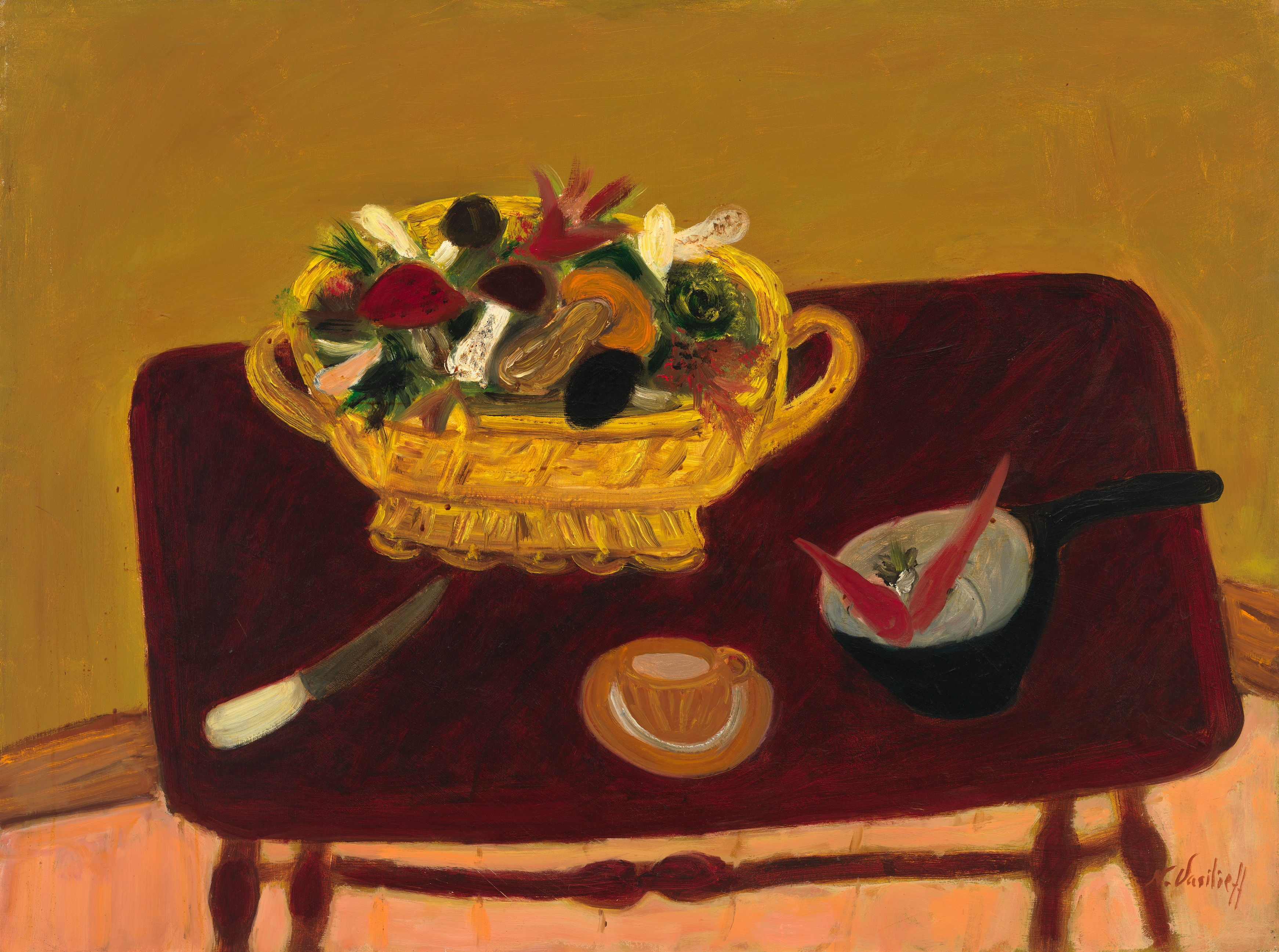Archive
Nikolai Vasilieff
- Nikolai
- Vasilieff
Николай Васильев, Nicholas Vasilieff, Nikolai Vassilieff
- 03-11-1887
- Moscow Oblast (RU)
- 13-10-1970
- Williamstown (US)
- PainterScene DesignerMuralist
Vasilieff was not only one of the Union of Russian Painters in Istanbul’s leaders, but he is also remembered for his stage settings and costumes for the ballet Scheherazade at the Theatre des Petits Champs.
Word Count: 36

Consuelo Kanaga (American, 1894-1978). [Untitled] (Nicholas Vasilief, Painter). Gelatin silver photograph, 9 5/8 x 7 5/8 in. (24.4 x 19.4 cm). Brooklyn Museum, Gift of Wallace B. Putnam from the Estate of Consuelo Kanaga, 82.65.414 
Consuelo Kanaga (American, 1894-1978). [Untitled] (Nicholas Vasilief, Painter). Gelatin silver photograph, 9 5/8 x 7 5/8 in. (24.4 x 19.4 cm). Brooklyn Museum, Gift of Wallace B. Putnam from the Estate of Consuelo Kanaga, 82.65.414 
Nicholas Vasilieff, Still Life With Mushrooms, 1960. Oil on linen, 30 × 40 1/8 in. (76.2 × 101.9 cm). (Whitney Museum of American Art, New York; gift of Mrs. Ansley W. Sawyer 61.59). Anonymous. “Vystavka Kartin.” Presse du Soir, 20 October 1921, p. 4.
Anonymous. “Scheherazade.” Presse du Soir, 31 December 1921, p. 2.
Anonymous. “Russkoye iskusstvo za granitsey.” Teatr i Zhizn’, January 1922, n.p.
Anonymous. “Nicholas. J. Vasilieff, 82, Dead; Artist an Emigre from Moscow.” New York Times, 14 October 1970, p. 50.
Bournakine, Anatoliy, and Dominic Valery, editors. Al’manah Na Proschaniye. The Farewell Almanac. L’Almanach Nos Adieux (1920–1923). Imp. L. Babok & fils, 1923.
Chave, Anna. “Nicholas Vasilieff.” Société Anonyme Catalogue: Modernism for America Resources, edited by Jennifer R. Gross, exh. cat. Yale University Art Gallery, New Haven, 2006, pp. 677–678.
Friberg, Hedda. “Vasilieff at the Benton.” Connecticut Daily Campus, 20 April 1977, p. 4.
Leykind, Oleg, et al. Hudojniki Russkogo Zarubej’ya (1). Izd.dom “Mir”, 2019, pp. 335–336.
Scott, Martha B. "N. Vasilieff Rediscovered in Colorful UConn Show." Bridgeport Sunday Post, 22 May 1977, p. 71.
Ted’. “K Vystavke Hudojnikov.” Presse du Soir, 29 June 1923, n.p.
Word Count: 137
Slavonic Library (Slovanská knihovna) in Prague.
Word Count: 6
Istanbul, Ottoman Empire/Turkey (1920–1923); New York, United States (1923–1966).
Küçük Yazıcı 4 (now presumably Tarlabaşı Blv. 79), Hüseyinağa, Beyoğlu, Istanbul (studio); Union Square, New York (studio).
- Istanbul
- Ekaterina Aygün. "Nikolai Vasilieff." METROMOD Archive, 2021, https://archive.metromod.net/viewer.p/69/2949/object/5138-10440325, last modified: 14-09-2021.
-
Vladimir BobritskyPainterScene DesignerGraphic ArtistMusicianIstanbul
Bobritsky worked at the Theatre des Petits Champs, where he successfully dealt with stage designs and costumes, at the same time he participated in the Union of Russian Painters in Constantinople.
Word Count: 31
Wladimir IvanoffPainterSculptorIstanbulNot only did Ivanoff become one of the founders and chairman of the Union of Russian Painters in Constantinople, but he also became famous for “Drawing Thursdays”, which took place at his apartment.
Word Count: 33
Leonid TomiloffScene DesignerDecoratorIstanbulAs a professional scene-designer, Leonid Tomiloff was in high demand in Istanbul. For many years, he worked at the Theatre des Petits Champs and was the chief decorator of the Constantinople Commercial Club.
Word Count: 33
First Russian émigré artists in Istanbul exhibitionExhibitionIstanbulThe first Russian-speaking émigré artists in Istanbul exhibition was a one-day event but its success led to the formation of the Union and paved the way for other exhibitions.
Word Count: 29
Exhibition of Russian émigré artists at Taksim Military BarracksExhibitionIstanbulThe exhibition of Russian-speaking émigré artists at Taksim Military Barracks was the first major exhibition organised by the Union of Russian Painters in Constantinople.
Word Count: 24
Union of Russian Painters in ConstantinopleAssociationIstanbulThe Union existed for less than two years but in that short space of time a tremendous amount of work was done by its members, refugees from the Russian Empire.
Word Count: 30
New School for Social ResearchAcademy/Art SchoolPhoto SchoolUniversity / Higher Education Institute / Research InstituteNew YorkDuring the 1940s and 1950s emigrated graphic designers and photographers, along with artists and intellectuals, were given the opportunity to held lectures and workshops at the New School for Social Research.
Word Count: 31
Vera KuznetzovaArtistDesignerIllustratorShanghaiA native of Harbin and a resident of Shanghai in the 1930s and 1940s, Vera Kuznetzova was among the most accomplished female artists of the Russian diaspora. Together with Mikhail Kichigin, she travelled extensively around China and Eastern Asia, exhibiting her work and conducting visual studies.
Word Count: 46